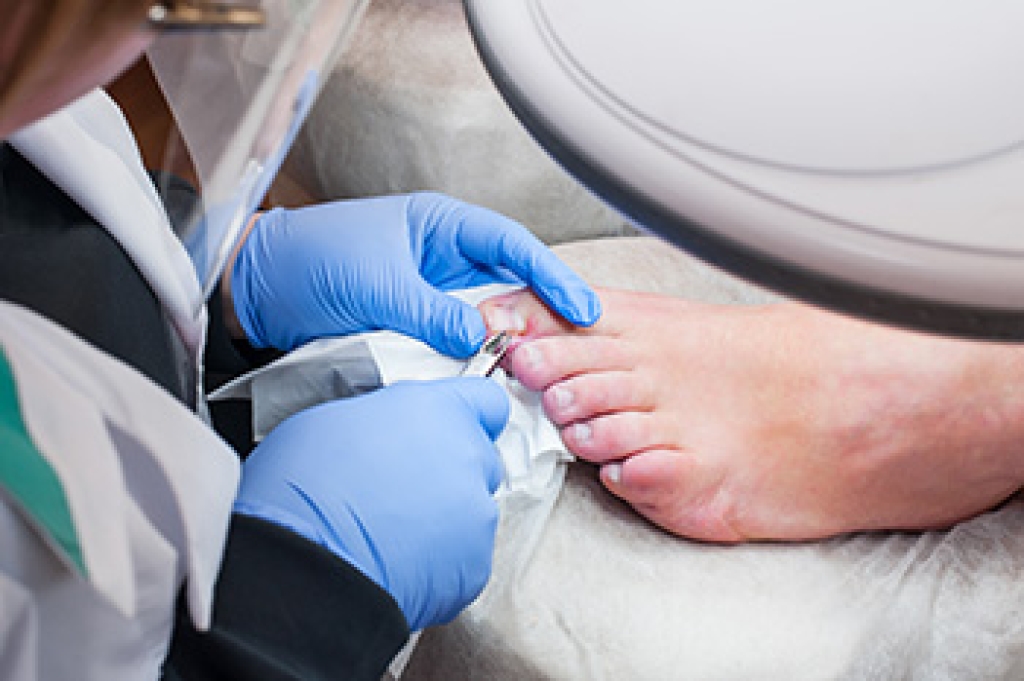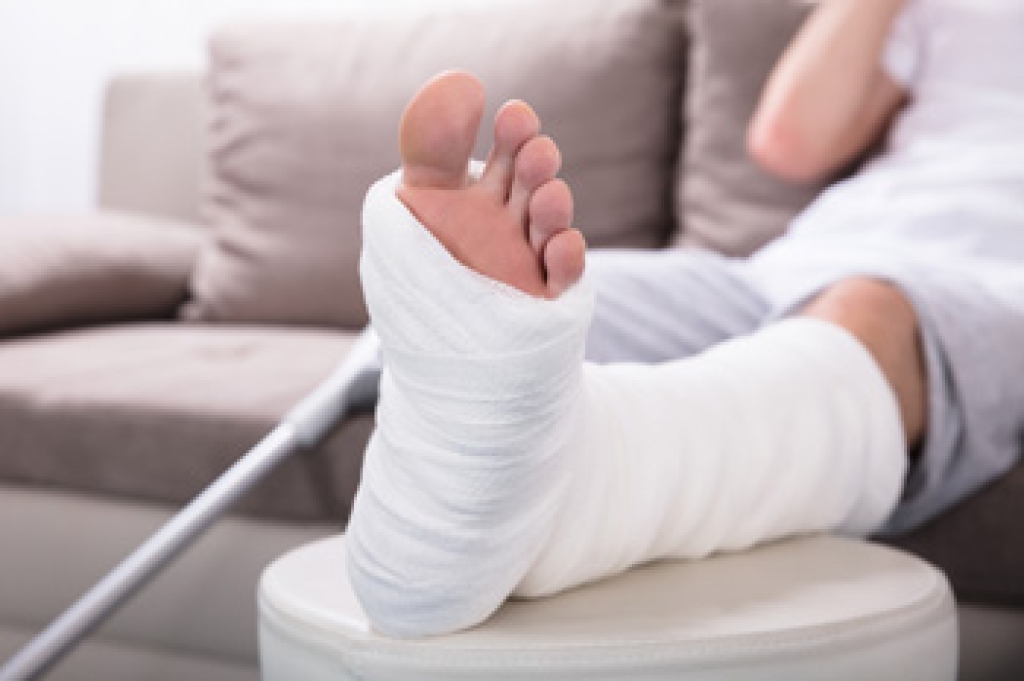Connect With Us
Blog
Blog
Is My Ankle Sprained or Broken?
It can sometimes be difficult to distinguish between an ankle sprain and a broken or fractured ankle. A sprain occurs when the ligaments in the ankle are overstretched or torn, while a fracture occurs when a bone in the ankle is broken. Both injuries can cause pain, swelling, bruising, and tenderness in the affected ankle, although an ankle fracture is usually more painful than a sprain. Those who have sprained their ankle may feel a popping sensation at the time of injury and experience ankle instability and a reduced range of motion. Those who have broken their ankle can have trouble bearing weight on the foot and may notice a visible deformity in the ankle, especially in cases where the ankle is also dislocated. If you have symptoms of an ankle sprain or an ankle fracture, it is strongly suggested that you see a podiatrist, who can diagnose and treat your condition.
Broken ankles need immediate treatment. If you are seeking treatment, contact Gerald Erskine, DPM from Seneca Family Footcare. Our doctor can provide the care you need to keep you pain-free and on your feet.
Broken Ankles
A broken ankle is experienced when a person fractures their tibia or fibula in the lower leg and ankle area. Both of these bones are attached at the bottom of the leg and combine to form what we know to be our ankle.
When a physician is referring to a break of the ankle, he or she is usually referring to a break in the area where the tibia and fibula are joined to create our ankle joint. Ankles are more prone to fractures because the ankle is an area that suffers a lot of pressure and stress. There are some obvious signs when a person experiences a fractured ankle, and the following symptoms may be present.
Symptoms of a Fractured Ankle
- Excessive pain when the area is touched or when any pressure is placed on the ankle
- Swelling around the area
- Bruising of the area
- Area appears to be deformed
If you suspect an ankle fracture, it is recommended to seek treatment as soon as possible. The sooner you have your podiatrist diagnose the fracture, the quicker you’ll be on the way towards recovery.
If you have any questions, please feel free to contact our office located in Ronceverte, WV . We offer the newest diagnostic and treatment technologies for all your foot care needs.
Advanced Treatment for Ingrown Toenails

Surgical treatment for ingrown toenails focuses on relieving pain, reducing infection, and preventing the nail from growing into the skin again. When the side of a toenail digs into the skin, it can cause redness, swelling, and tenderness. If left untreated, the area can become infected and make walking uncomfortable. For more severe or recurring cases, a podiatrist can perform one of several surgical procedures in which a small part of the toenail or the skin around it is carefully removed to stop the edge of the nail from digging into the toe. This helps the nail grow straight and prevents it from cutting into the skin again. The procedure is done under local anesthesia, and healing usually occurs within a few weeks. A podiatrist can determine which approach will provide lasting relief and promote healthy nail growth. If you have a painful or recurring ingrown toenail, it is suggested that you make an appointment with a podiatrist for a diagnosis and treatment.
Ingrown toenails can become painful if they are not treated properly. For more information about ingrown toenails, contact Gerald Erskine, DPM of Seneca Family Footcare. Our doctor can provide the care you need to keep you pain-free and on your feet.
Ingrown Toenails
Ingrown toenails occur when a toenail grows sideways into the bed of the nail, causing pain, swelling, and possibly infection.
Causes
- Bacterial infections
- Improper nail cutting such as cutting it too short or not straight across
- Trauma to the toe, such as stubbing, which causes the nail to grow back irregularly
- Ill-fitting shoes that bunch the toes too close together
- Genetic predisposition
Prevention
Wearing proper fitting shoes and using proper cutting techniques will also help decrease your risk of developing ingrown toenails.
Treatment
Ingrown toenails are a very treatable foot condition. In minor cases, soaking the affected area in salt or antibacterial soaps will not only help with the ingrown nail itself, but also help prevent any infections from occurring. In more severe cases, surgery is an option. In either case, speaking to your podiatrist about this condition will help you get a better understanding of specific treatment options that are right for you.
If you have any questions, please feel free to contact our office located in Ronceverte, WV . We offer the newest diagnostic and treatment technologies for all your foot care needs.
What You Should Know About Peripheral Artery Disorders

Peripheral artery disorders occur when circulation to the legs and feet becomes restricted because the arteries have narrowed or hardened. As blood flow decreases, the muscles and skin do not receive enough oxygen, leading to cramping during activity, fatigue in the calves, or a heavy feeling that improves with rest. Some people notice their feet feel cooler than usual or see wounds taking much longer to heal. These circulation problems often develop gradually and are influenced by aging, smoking, diabetes, high cholesterol, and high blood pressure. Recognizing the early signs matters because untreated poor circulation can lead to infections or chronic ulcers. With proper diagnosis, treatment options can improve comfort and help protect long-term mobility. If you notice persistent foot discomfort, numbness, or slow-healing sores, it is suggested that you see a podiatrist for an evaluation and appropriate care.
Peripheral artery disease can pose a serious risk to your health. It can increase the risk of stroke and heart attack. If you have symptoms of peripheral artery disease, consult with Gerald Erskine, DPM from Seneca Family Footcare. Our doctor will assess your condition and provide you with quality foot and ankle treatment.
Peripheral artery disease (PAD) is when arteries are constricted due to plaque (fatty deposits) build-up. This results in less blood flow to the legs and other extremities. The main cause of PAD is atherosclerosis, in which plaque builds up in the arteries.
Symptoms
Symptoms of PAD include:
- Claudication (leg pain from walking)
- Numbness in legs
- Decrease in growth of leg hair and toenails
- Paleness of the skin
- Erectile dysfunction
- Sores and wounds on legs and feet that won’t heal
- Coldness in one leg
It is important to note that a majority of individuals never show any symptoms of PAD.
Diagnosis
While PAD occurs in the legs and arteries, Podiatrists can diagnose PAD. Podiatrists utilize a test called an ankle-brachial index (ABI). An ABI test compares blood pressure in your arm to you ankle to see if any abnormality occurs. Ultrasound and imaging devices may also be used.
Treatment
Fortunately, lifestyle changes such as maintaining a healthy diet, exercising, managing cholesterol and blood sugar levels, and quitting smoking, can all treat PAD. Medications that prevent clots from occurring can be prescribed. Finally, in some cases, surgery may be recommended.
If you have any questions, please feel free to contact our office located in Ronceverte, WV . We offer the newest diagnostic and treatment technologies for all your foot care needs.
Toenail Fungus and When to Seek Podiatric Care

Toenail fungus affects the nails and surrounding tissue, often beginning as a small white or yellow spot that gradually spreads. Symptoms may include thickened nails, discoloration, brittleness, crumbling edges, or an unpleasant odor. Causes include exposure to fungal organisms in warm and moist environments, such as locker rooms or tight footwear. Risk increases for older adults, people with sweaty feet, those with weakened circulation, and individuals who frequently walk barefoot in public areas. A podiatrist can diagnose the infection, provide advanced treatments, trim damaged nails, and offer guidance to prevent future problems. If you have any of the above symptoms, it is suggested that you schedule an appointment with a podiatrist who can offer effective relief and treatment solutions, which may include prescribed medication.
For more information about treatment, contact Gerald Erskine, DPM of Seneca Family Footcare. Our doctor can provide the care you need to keep you pain-free and on your feet.
Toenail Fungus Treatment
Toenail fungus is a condition that affects many people and can be especially hard to get rid of. Fortunately, there are several methods to go about treating and avoiding it.
Antifungals & Deterrence
Oral antifungal medicine has been shown to be effective in many cases. It is important to consult with a podiatrist to determine the proper regiment for you, or potentially explore other options.
Applying foot powder on the feet and shoes helps keep the feet free of moisture and sweat.
Sandals or open toed shoes – Wearing these will allow air movement and help keep feet dry. They also expose your feet to light, which fungus cannot tolerate. Socks with moisture wicking material also help as well.
If you have any questions please contact our office located in Ronceverte, WV . We offer the newest diagnostic and treatment technologies for all your foot and ankle needs.
Blog Archives
- 2025
- 2024
- 2023
- 2022


